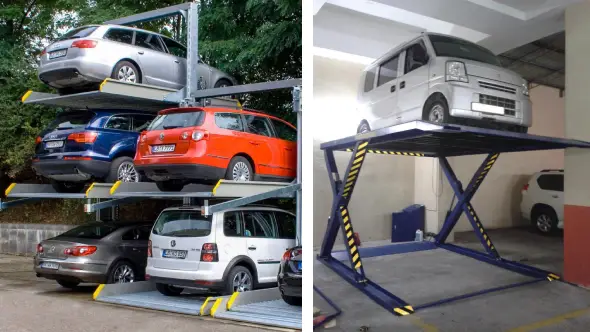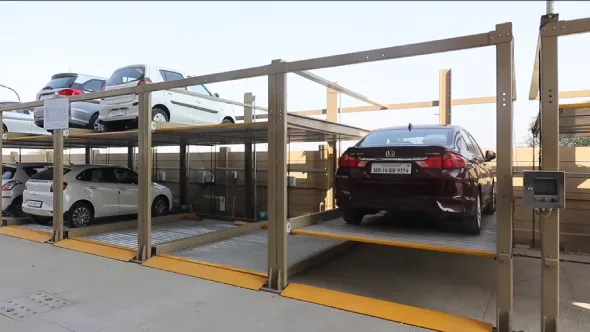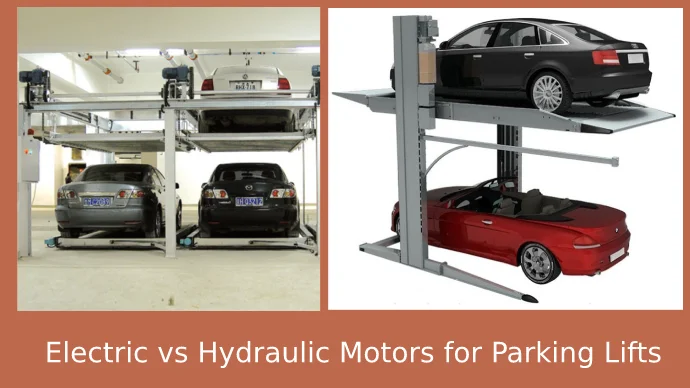Last Updated on April 12, 2023
Are you at a crossroads when it comes to choosing the right motor for your parking lift? We’ve got all the info on electric and hydraulic motors so that you can easily make an informed decision. Not only will this choice affect your wallet but also our environment, so don’t take it lightly.
Not all parking motors are equal, they can both get the job done, but it’s essential to evaluate their distinct traits before choosing one.
Electric motor lifts provide a quieter, more eco-friendly solution that may incur higher upfront costs. Conversely, hydraulic models offer faster installation times with greater maintenance requirements to prevent leaks and noise pollution.
Let’s compare and contrast those two choices, digging into the nuances of each one to uncover their unique benefits and drawbacks.
Comparison Of Electric Vs Hydraulic Motors For Parking Lifts

In parking lots, lifts are often used to move cars up and down levels. This is especially true for multi-story car parks. Electric and hydraulic motors are commonly used in these lifting applications. So what’s the difference between these two types of motors?
Here are the main points of comparison:
Power Output
Electric motors can produce high power outputs due to their ability to directly control the speed and direction with variable frequency drives (VFDs). In addition, they tend to be more efficient as they can draw power directly from the grid without any losses in energy transfer.
Conversely, hydraulic motors rely on a pressurized liquid medium to generate motion, which makes them less efficient than electric motors. Despite this, they do have the advantage of being able to produce higher torque than electric motors because of their higher pressure ratings.
Installation Requirements
When it comes to installation requirements for electric motors, they need more space due to the complexity of wiring needed for closed-loop control with VFD controllers. Compared to hydraulic motors, which need an open loop control system and an external pressure relief valve, hydraulic motors take up less space.
This makes them easier and cheaper to install than electric motors.
Cost
The cost associated with both types of motor systems varies depending on their size and power rating. Though, an electric car elevator tends to be more expensive than a hydraulic car lift. This Is mainly because they require more complicated wiring due to their reliance on VFD controllers for speed/direction changes.
Meanwhile, hydraulic systems may initially cost more due to their complexity and higher pressure ratings required. They generally end up being cheaper over time because of their lower maintenance costs compared with electric motor systems.
Responsiveness
In terms of responsiveness between electric and hydraulic motor systems, electric motors tend to offer quicker response times. This Is mainly because VFD controllers can instantly adjust speeds or directions when commanded by them.
Hydraulic motor systems, meanwhile, are limited by their inability to quickly adjust speeds or directions without changing the pressure in the hydraulic system. As such, this makes them slower at responding than electric motor systems.
Since there is often a delay before such adjustments can occur within the fluidic mediums used within its design architecture.
Loudness
Generally speaking, both types of motor technology produce some noise when running. While an electric motor car lift tends to be much quieter than Hydraulic Motors because they don’t rely on valve opening/closing. Which is where most of the noise originates from when running a hydraulic motor car lift.
This makes them preferable for residential areas or indoor applications where quiet operations are preferred or necessary.
Maintenance Requirements
Electric Motors typically require less maintenance when compared to hydraulic systems. Since they don’t use any type of oil or lubricants inside them, it eliminates any risk of leakage like what you experience with a traditional hydraulic lift system.
In contrast, Hydraulic Motors usually require regular maintenance, such as replacing filters, checking fluid levels, etc. If you want your system to work optimally over time. So there’s a trade-off between initial cost savings with hydraulic systems and long-term benefits with regular maintenance.
Electric vs Hydraulic Motors Parking Lifts: How Do They Work?

Electric motor parking lifts work differently than hydraulic motors. An electric motor is connected to a lead screw, which controls the lift’s vertical movement and is powered by electricity. The motor turns the lead screw, causing the lift to move up or down as desired.
This type of lift does not require any additional power unit, such as oil or gas, to run and is generally quieter than hydraulic lifts. Moreover, electric motors offer greater speed than hydraulic lifts. They can move quickly from one level to another without waiting for the system to build pressure.
Hydraulic motor parking lifts make use of oil pressure instead of electricity. Instead of an onboard motor, they employ a pump that pushes oil into a hydraulic cylinder which then moves the lifting mechanism attached to it.
The movement is also smooth, but unlike an electric system, a hydraulic lift requires a constant supply of oil for them to work effectively and efficiently.
Advantages & Disadvantages of Hydraulic And Electric Motor Parking Lifts
With the rise of electric and hydraulic-powered parking lifts, car owners can truly benefit from taking a closer look into what each system has to offer. If you weigh out your options, you’ll make an informed decision when it comes time to find the perfect lift for your needs.
Advantages Of Electric Motor Parking Lifts:
- Much quieter operation than hydraulics, making it ideal for indoor applications.
- Improved accuracy in motion control, as well as greater control over speed.
- Less maintenance is required since there are fewer working parts.
- No risk of oil leakage or contamination.
- Not reliant on pressurized fluids, so there is no need for a tank or hydraulic pump.
- The smaller overall design allows it to fit into tighter spaces.
- Can reach higher speeds than hydraulics
Disadvantages of Electric Motor Parking Lifts:
- More Expensive Investment for Installation and Operation
- Difficult to Install Without Professional Assistance
- Difficulty in detecting problems until after serious damage has occurred
- Poor Performance in Extreme Temperatures and Conditions
Advantages of Hydraulic Motors for Parking Lifts:
- High torque output relative to electric motors, allowing for greater lifting capacities.
- Fast start-up times compared to electric motors as it does not require an electrical charge buildup before beginning operation.
- Ability to be powered by combustion engines, giving them independent operation from an external power unit.
- Greater flexibility in design compared to other lift systems, allowing for custom shapes and sizes.
Hydraulic Motors Parking Lifts Disadvantages:
- Costlier than electric motors from purchase and installation costs through maintenance and repair costs due to the use of oil or other lubricants.
- Noise pollution is normally higher with hydraulic motors due to the pumping action taking place inside the motor chambers and valves.
- The possibility of leaks can be higher with the hydraulic system.
What Should You Never Do With Electric & Hydraulic Motor Parking Lifts?
When it comes to motor parking lifts, there are two main types: electric and hydraulic. In order to ensure the safety and longevity of your motor parking lift, there are certain guidelines you should always follow. No matter what kind you have.
You shouldn’t do these things:
1. Never Overload Your Lift: Both electric and hydraulic lifts have a weight limit that cannot be exceeded. If you attempt to overload your lift, it can lead to serious damage or even failure. Be sure to check the manufacturer’s manual for the exact weight limit before loading up your vehicle on the lift.
2. Don’t Use Damaged Lifts: Both electric and hydraulic lifts must be checked regularly for signs of wear and tear, such as fraying cables, loose bolts or rusty parts. Any damaged components should be replaced immediately to keep the lift functioning safely and correctly.
3. Don’t Move Your Lift Without Proper Support: Lifts should be moved using wheeled jacks or pneumatic tires, not just dragged across flat surfaces. It will also reduce strain on the motors and cables since friction against the floor, or other surfaces won’t cause damage.
4. Avoid Exposure To Extreme Heat Or Cold: If parking lifts are exposed to extreme temperatures for too long, they may malfunction or even break down completely. Keep outdoor installations away from direct sunlight in the summer and furnaces in the winter to prevent damage to their internal components.
5. Skip The DIY Repairs: While it may seem like a good idea initially, attempting any repairs on your own is never recommended. Especially when dealing with complex electrical systems like those found in an electric car parking lift or hydraulic mechanisms like traditional car parking lifts.
Is It Possible For a Hydraulic Motor Parking Lift to Fail?
Parking lifts powered by hydraulic motors can fail. This usually happens when the mechanical lock fails to engage due to damage or does not move freely on its axis. Another common cause of failure for hydraulic motor parking lifts is the loss of hydraulic pressure.
When this occurs, the lift begins to lower at an accelerated rate as oil leaks out of the system or is pushed back into it. Poor maintenance can also lead to a failed motor parking lift as debris accumulates in the system and causes blockages that prevent proper functioning.
Aside from that, if there are any gas bubbles in the system, they can impede the flow of hydraulic fluid and lead to total system failure.
Can An Electric Motor Parking Lift Fail?
Indeed, an electric motor parking lift can fail due to a number of reasons. Overloads can damage electric motors, surges in voltage or current levels, vibrations or shocks, and corrosion or oxidation on contact points due to moisture or humidity buildup in the environment around them.
Besides that, poor electrical connections between the motor and the power supply source can also contribute to electrical motor failure. It is important to check all connections regularly and keep them clean and free from corrosion to avoid any electrical malfunctions with the system.
Which Parking Lifts Reliable: Electric Vs Hydraulic Motors
Electric and hydraulic motors for parking lifts are both highly reliable options that offer a variety of benefits depending on the application.
Electric motor lifts tend to be quieter and more environmentally friendly than their hydraulic counterparts but may require higher initial costs in some cases. Hydraulic motor lifts usually require less installation time than electric but can be louder in operation and pose a higher risk of leaks or spills if not properly maintained.
Ultimately, it’s up to you to determine which type of motor lift is right for your needs based on budget constraints, environmental impact concerns and other considerations such as installation requirements and maintenance schedules.
With the insights provided in this blog post, at least you should have all the information necessary to choose wisely.
